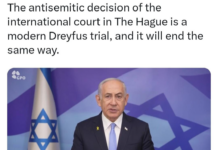Jabhat al-Nusra’s victory over the US-backed Syrian Revolutionaries Front (SRF) and Hazzm Movement in Idlib last week was a massive blow for American hegemony, writes Ali Harfouch.
Jabhat al-Nusra (JN) continued to capture more territory from the loosely-formed “Free Syrian Army” (FSA) after having driven the “moderate” rebels out of their strongholds in the northern province of Idlib last week.
The significance of JN’s seizure of the Western-backed Hazzm movements’ headquarters in Der Sonnbol cannot be overstated. Syria’s Idlib has come to represent the symbolic battle ground between two competing orders, two fundamentally incommensurable logics – the Eurocentric Westphalian world-order and the prospects of a “radical Islamist order”.
This left Abdul Hakim Bashar, vice president of the Syrian National Coalition (SNC) warning that the U.S. and the political order it represents had lost their credibility among Syrians, not to mention, a widespread disenchantment among “moderate” Syrian rebels who are now left, without sufficient arms, fighting Assad’s regime, ISIS and JN.
U.S. hegemony
These developments are not merely the result of President Barak Obama’s foreign policy blunders or the U.S.’ impotence towards the Syrian crisis – nor can it be attributed to any parochial interests of JN because a number of other Jihadist groups, with diverging interests, joined JN in its fight against the “moderate” rebels of Idlib.
What is ensuing in Idlib is something far more critical. To understand what is at stake in this battle and the significance of JN’s strategic victories, it is critical that we understand the difference between a hegemonic order and a dominant order, as well as the ways in which the former maintains its hegemony.
Subscribe to our newsletter and stay updated on the latest news and updates from around the Muslim world!

A state becomes hegemonic when its ideological precepts and strategic interests shape what is perceived (by those in the periphery) as the “natural order” and consequently allowing the hegemonic state to determines what political actions and visions are “possible” and which are “impossible” i.e. abnormal.
However, when the realm of the possible and the impossible are challenged, the state loses its hegemony and instead relies on domination, meaning that, it must coercively impose options.
Political actors who manoeuvre under a hegemonic political order and its global matrix of power-systems are cognitively debilitated and unable to think of political trajectories beyond the political order of the hegemon.
In the Muslim world, political actors could not perceive of an “order” and a political trajectory which lay beyond the neo-liberal and Westphalian international system. The “nation state”, “the Republic” and “democracy” did not represent ideological manifestations of a secular worldview espoused by the hegemon (U.S.) but were perceived as fixated and natural constructs which limited any political party of movement.
Arab Spring
However, in 2011, a series of events in the Muslim world challenged the hegemon and were able to do so for two primary reasons: (1) the political order and landscape in the Muslim world was unsustainable and (2) Islam posited an ideological alternative to the hegemon and challenged the “natural order” – it did so precisely by allowing political actors in the Muslim world to recognise the “natural” as being unnatural, external and illegitimate.
In short, the emergence of the uprisings in the Muslim world provided the nascent political actors with a degree of intellectual autonomy. Unlike the “anti-colonial” uprisings and revolutions in Latin America and Africa, the Muslim world could draw on a worldview which was intrinsically political. The Syrian revolution represents the most explicit example of such.

The Arab Spring created a problem for the U.S.; political action was no longer being undertaken through malleable and formal channels of participation like parliament, appeals to the United Nations (UN), the securing of treaties and agreements, and so forth.
Formal participation means that the U.S. can mediate and manage change, more importantly; it can determine what outputs were “possible” and which were “impossible” – reform was possible, but radical change was impossible.
Accordingly, the U.S. found itself forced to identify “opposition” actors who, although expressed their dissatisfaction with the prevailing political order through means outside of the “system”, still recognised the legitimacy of that system.
Another challenge to the hegemon was the Islamic sentiment which symbolised these revolutions – and since Islam is not a derivative of colonialism – it posed a major threat in that it could potentially call into question the ideological boundaries of the world-order.
To avert a potential crisis, the revolutions in Egypt, Tunisia, Yemen and Libya were aborted and put back onto the path of reform and the Islamic sentiments were dissipated by allowing malleable and pragmatic “moderate” Muslims to govern, albeit, not for long.
Syria
Syria however proved to be different. The “moderates” were nowhere to be found in Syria, having been either exiled or co-opted by the regime, new “radical” political actors emerged.
The Syrian Revolutionaries Front (SRF) and the Hazzm movement who formed the FSA were demarcated by their ideological, albeit opportunistic, commitments to democracy and the concept of nationalism. In turn, they served as ideal ground allies for the U.S. which went on to supply the “moderate” rebels with American made TOW missiles and other types of weaponry vis-à-vis a covert CIA operation launched in 2014.

In an attempt to resuscitate any minimal credibility it still had, the Western-backed SNC’s interim PM Ahmad Toumeh announced that the coalition was working towards forming a “Syrian National Army” and was doing so in coordination with the FSA.
A week later, the two biggest factions within the FSA (the SRF and Hazzm) were defeated by the Al-Qaeda affiliated JN and driven out of their strongholds in Idlib.
In the case of Hazzm, its fighters withdrew from their headquarters in Der Sonnbol without a fight, not to mention reports of mass defections.
This brings us back to what I said in the introduction of the article, Idlib represent the battle ground for two possible trajectories in the Muslim world, one of which is represented by the SRF on one hand an alternative trajectory represented by JN.
And if the defeat of the “moderates” in Idlib represents anything it is the end of the American hegemon and the creation of new possibilities. In short, Idlib will come to represent both symbolically and politically the graveyard U.S. hegemony in Syria.
Ali Harfouch is a political activist and commentator based in Beirut, Lebanon.
@asharfouch




















